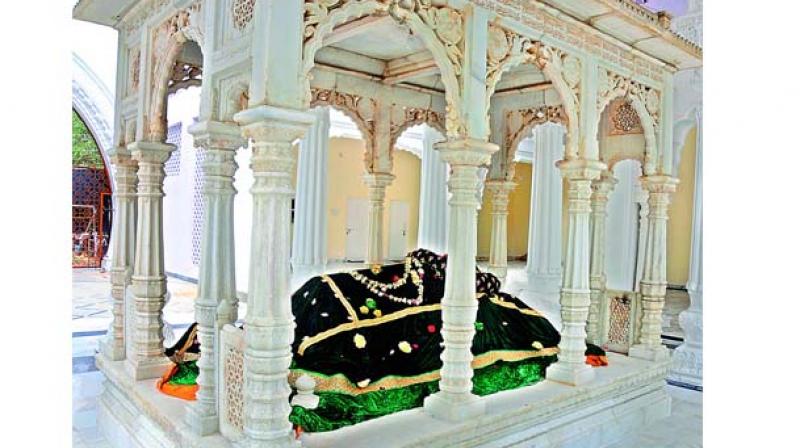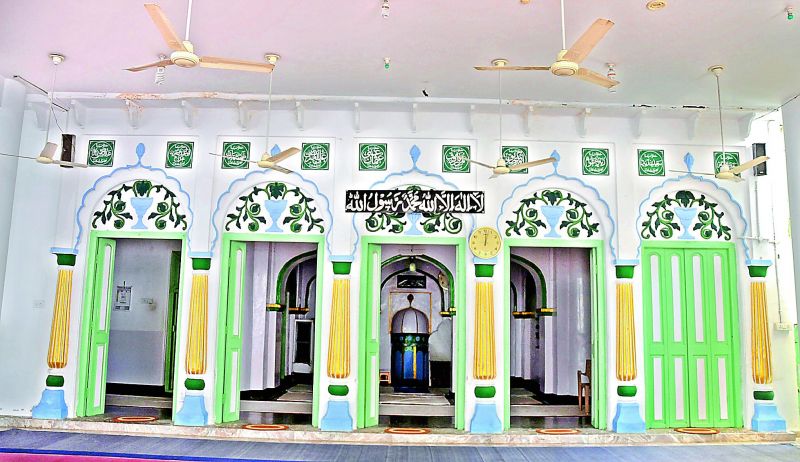Hyderabad: Oasis of peace in the crowd
The dargah also houses the grave of the VIIth Nizam's granddaughter.

Hyderabad: Nampally has a number of dargahs and masjids, most of them old and situated in the bylanes, a little off the Nampally Darusallam road. Most dargahs are known for their beautiful arches, which you can easily miss because of the crowded road. A few of the dargahs are very popular and well-maintained. The traffic on these roads is noisy and perpetual and there are houses situated in the bylanes, along with a few welding and carpentry shops.
Though only 100 yards away from the main road, the Dargah Hazrat Syed Shah Nooruddin Qumais Al-Qadri is a peaceful place with a green cover. It has a huge neem tree and a few sitaphal trees along with bushes growing wildly.
Crowning the dargah is an arch with Quranic verses etched on it. This arch is built in the old style with double pillars and jalis. Some renovation and rebuilding work is underway at the dargah and an attempt is being made to bring back the original look. A sima khana or a hall has been added to the building where students are taught during the daytime. This space is used for gatherings and festivities and has a sima khana for ladies too.
Three generations of saints from the same family are laid to rest at the dargah and their graves have a unique cannon-like projection on top, separating them from the others. The marble covering over Saint Nooruddin’s grave is beautiful. For over 250 years there were only four pillars, like a four-poster bed, and it was open to the sky. Some time back a covering was placed to the top, but the sides are still open and a beautiful embroidered covering speaks volumes of the honour in which this saint was held.

In one of the graves rests Sahabzadi Sakina Begum, a granddaughter of the late Nizam VII, Mir Osman Ali Khan Bahadur. She was married to Syed Shah Rafiq Moinuddin Qumais, the great grandson of Hazrat Syed Shah Nooruddin Qumais Al-Qadri. A small board on her grave declares her royal background and her relationship with the Nizam. This dargah speaks volumes of Sufi and Asaf Jahi culture in Hyderabad.
Sufi saint Hazrat Syed Shah Nooruddin Qumais Al-Qadri was born in Sadhuara in the Yamunanagar district of Haryana in 1803. He was the son of a pious Sufi saint, Hazrat Syed Shah Gulam Hussain Qumais Al-Qadri alias Luthf Ali. He was the ninth descendant of the well-known Sufi saint of the time, Syed Shah Qumess-e-Azam, and 17th descendant of the great Hazrat Syed Shaikh Abdul Qader Gilani.
The Sufi saint completed his education under the supervision of his father and then received a spiritual direction to come to the Deccan and start preaching to the masses here. On his way to the Deccan, Hazrat Syed Shah Nooruddin Qumais-Al-Qadri reached the tomb of Sufi saint Hazrat Qutbuddin Baqtiar Kaki at Delhi.
He stayed and preached there for some time and then continued his journey towards south, taking another break at Gwalior. Finally, he reached Hyderabad State in 1834.
Hazrat Syed Shah Nooruddin Qumais AlQadri did not have a place to stay and preach. So he decided to take shelter at the nearby tomb of Dargah Yousufain at Nampally and started preaching and serving society.
Soon he came across a mosque in Nampally, which later came to be known as Masjid-e-Deodi, where he saw the locals drinking toddy regularly. Though he preached and tried to explain the ill-effects of alcohol to them, he realised that people were averse to changing their habits.
He then took a handful of pebbles and threw them all over the toddy farm. The next morning all the toddy trees dried up. People realised that it was because of the saint’s prayers that the toddy trees were destroyed. A report of this incident went to the then ruler, Nizam IV Naser ud Daula.
Impressed by the news, the Nizam came to meet the Sufi saint. The Nizam was so captivated by his preaching that he immediately expressed his intention to become the saint’s disciple. At first, the Sufi saint did not heed the request, but later accepted on the Nizam’s persistence. Nizam Naser ud Daula then gifted some property to the Sufi saint.
On receiving the gift, the saint decided to go on a thanksgiving pilgrimage to Macca in 1844. He went once again to Macca in 1860, when he also visited Karbala and Najaf and returned to Hyderabad in 1861. By then, Nizam V Afzal ud Daula had succeeded his father to the throne, became a disciple and gifted the Sufi saint huge properties.
The Sufi saint died at the age of 77, on October 4, 1878. The Syed Nooruddin Shah Qadri Rehmatullah Aleh masjid is where the saint lived in a small room. Here too there is a sima khana that is used for education and on important occasions. This is also a very old masjid, with old doors and beautiful stucco decorative work that has been painted over. And across this stucco relief are Quranic quotes or suras from the Quran.
Even though there were a lot of properties most of the empty spaces have been taken over by cheek-by-jowl construction. Earlier, there was a main entrance to the mosque with the masjid’s flag flying on a tall wooden pole. But a lot of land was taken away for road widening and now there is another entrance and the flag now flies on a metal post inside the masjid.
The muttawali of this dargah is a hereditary descendant, Syed Shah Faraz Moinuddin Qumais. While rebuilding the dargah, the family built rooms so that they can stay there for important occasions. The family plans to start free tuitions for poor students from Classes 9 to 12 and vocational training for unskilled labourers from next year.

